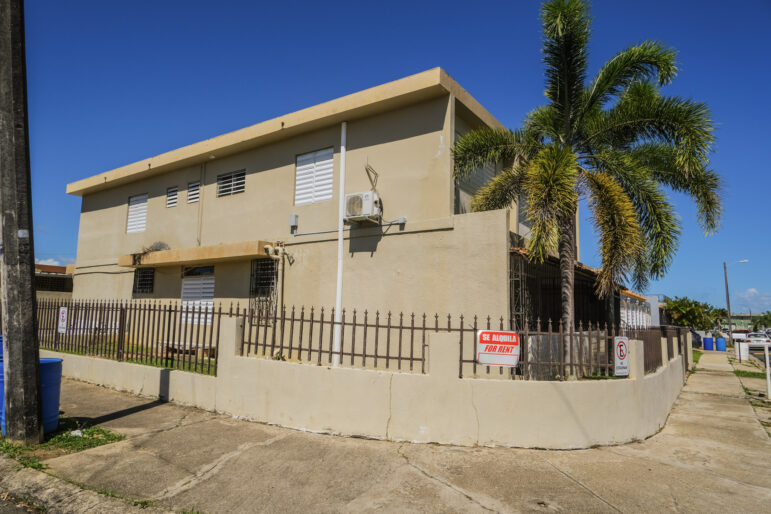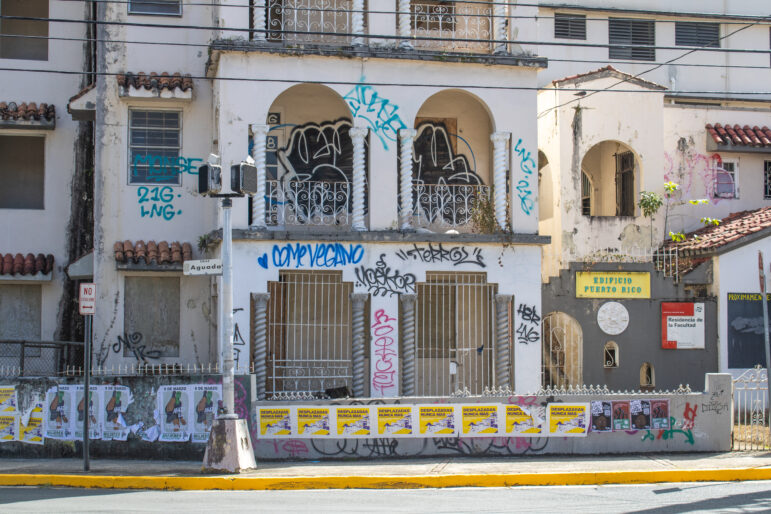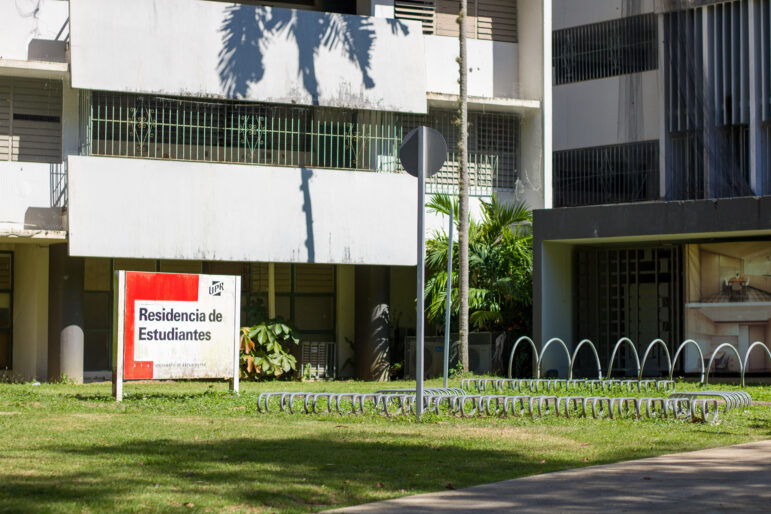The University of Puerto Rico’s Humacao Campus has never had student housing. However, data from the UPR’s Central Administration shows that 40.4% of its 2,634 students live in apartments while they wait for the construction of a 40-unit student dorm, designed three years ago and still to be auctioned.
At the Río Piedras Campus, the contracts for the design of the remodeling of Torre Norte and Resi Campus student dorms were awarded three and four years ago, respectively. A bidding process was just opened in February to rehabilitate ResiCampus.
Meanwhile, the Fiscal Control Board (JCF, in Spanish) approved a contract for the remodeling of the Hotel Colegial of the UPR Mayagüez Campus (RUM, in Spanish) while a public-private partnership proposed six years ago does not even have a designated committee to negotiate the agreement to build residences on the campus grounds.
In the absence of an institutional response to the lack of student dorms and the general shortage of affordable housing, UPR students are forced to pay for increasingly expensive apartments, the Center for Investigative Journalism (CPI, in Spanish) confirmed in interviews with students of those three campuses, as well as housing landlords in Humacao.
“The issue of vulnerability among the students is real. Some of them are paying absurd $1,000-plus monthly rent for a space that’s certainly not worth that. There are fewer and more expensive accommodations. I know there is inflation and all, but there are times when it is abusive,” said the president of the Humacao Campus General Student Council, Luis Onel González, who stressed that most hurricanes hit the island from the eastern zone, which makes the situation for this campus’ student body even more precarious.
In addition to the emergencies of the past five years, caused by hurricanes and earthquakes, the Fiscal Control Board cut $445 million from the UPR budget assigned from the Puerto Rico General Fund and imposed an increase between $56 and $157 for undergraduate credit through the institution’s Fiscal Plan. The credits will continue to increase in stages until 2027, reaching $177, according to the Plan.
The increase in the cost of higher education and inflation have influenced the change in the college student profile, who work while going to school. According to the Integrated Postsecondary Education Data System (IPEDS), which gathers data from all public and private universities in the United States and its territories — including Puerto Rico — 40% of full-time undergraduate students had a job in 2020 while 74% of part-time undergraduate students were employed.
The director of the UPR’s Physical Development and Infrastructure Office (ODFI, in Spanish), Julio Collazo, does not have an explanation for the years-long delay in calling on contractors for the construction and remodeling works of the dorms, but insisted that within the scope of the infrastructure projects, these are the “number one priority.” Collazo has been in that position since mid-2022. His predecessor, Adrián López Nunci, who is still an employee of the UPR, did not respond to calls and emails from the CPI asking him to explain the delay in publishing the bids for the remodelings in Río Piedras and the construction in Humacao.
Proposal for Humacao Solves Merely 3.8% of Student Residence Demand
Puerto Rico barely has 185 licensed student dorms, according to the Department of Consumer Affairs (DACO, in Spanish which regulates this economic activity but has failed to update the list of these businesses on its website since 2019. The Caguas region — which includes Humacao — only has nine licensed student dorm facilities.

Photo by Norenid Feliciano | Centro de Periodismo Investigativo
“We have [in Humacao] students from Jayuya, from Villalba, from Vieques, and these people have to grin and bear to be able to continue their professional careers,” said González, stressing how burdensome it is to be a college student in Puerto Rico, where the median household income is $21,967.
From the list of student housing available on the DACO website, the CPI identified six in the Villa Universitaria neighborhood, next to the Humacao Campus. Among the four landlords who answered calls, none had spaces available, and only two mentioned the possibility of vacancies in August.
“There are almost no dorms for students,” landlord Gloria Mojica acknowledged. Meanwhile, Iris Medina said she no longer has student dorms, but rather apartments for rent between $250 to $300 a month. Fermina Cruz, who has two rented student dorms, offers them at the same rate. Meanwhile, José Solís has all his apartments occupied at $500 per month.
For Alexander Ramírez Colón, an undergraduate student in Chemistry at the UPR in Humacao, it was not easy to find a dorm in Villa Universitaria because he could not find an updated registry identifying these residences. “They just hang up signs in front of the houses that they divided, where they put up gypsum boards, add another door to the room, and that’s your studio or apartment,” he said.
The $450 rate for the space where Alexander lives does not seem fair to him, because although it includes utilities, “it’s a room they built by attaching a zinc plank to the side of the house, where they put the kitchen and bathroom.” Everything the student earns in the federal work-study program goes to pay his monthly rent, and thanks to his family’s help, he can pay for his food and other personal expenses. “It’s not just my situation, it’s also that of many of my peers, who are studying and working, and on top of that, they have another job to be able to pay for their housing,” said Ramírez Colón, who grew in Villalba, an hour and a half drive from Humacao.
The bid to build the Humacao student housing complex opened in late 2022. González said that “the Humacao project came from a proposal some professors made after Hurricane María to the U.S. Department of Education for low-income students who are in danger of losing, or lost their homes due to a disaster.”
In October 2019, Marqués & Marqués Arquitectos got the $627,169 contract to design the Humacao project. This construction project with dorms for 40 students has an estimated cost of $8,033,200 and it is expected to open by the end of 2024. The architectural firm has carried out other projects for the UPR System, such as the expansion and remodeling of the Administrative Sciences building in Humacao and the remodeling of the student center and sports facilities of the Río Piedras Campus.
If There’s Nowhere to Live, Fewer Students Will Come to Río Piedras
The Río Piedras Campus had three student residences until 2020. In 2018, Torre Norte, on Avenida Universidad, closed and two years later, the Resi Campus, the former “Women’s Residence” located inside the campus. Now there are only the three towers at Plaza Universitaria, off campus on Ponce de León Avenue, with a capacity for 594 students for “a campus that has 12,000 students,” said the former president of the Río Piedras Campus General Student Council, Simonely Hidalgo.

Photo by Joan Cruz | Centro de Periodismo Investigativo
In 2020 prices for shared dorms at Plaza Universitaria started at $255, and individual units cost up to $570 a month, with water, electricity, and internet services included.
As in Humacao, Hidalgo believes that students are being priced out of the rental market.
“Existing private student housing is expensive because the way the landlords are handling it is that instead of renting and signing the contract with the student, they do it with the parent and then instead of being a dorm, according to DACO’s regulations, it simply becomes an apartment,” Hidalgo explained.
According to the DACO regulations, a dorm is any establishment, dwelling, building, part of a building, or individual apartment to provide accommodation to one or more students for a fee. Its owners or administrators must comply with the requirements of the Department of Health and the Fire Department, as well as “promote their ongoing improvement by guaranteeing a climate conducive to study.”
The UPR’s Central Administration justified the shutdown of Torre Norte because of the conditions it was left in after Hurricane María, and that of Resi Campus, to certain improvements planned for the structure. More than 2,000 university students from the Río Piedras Campus live in dorms.
For historian and professor at the UPR Río Piedras School of Architecture, Jorge Lizardi, “historically the University has never had the capacity to meet all the demand for dorms, and it’s probably one of the reasons why we have lost enrollment, especially in Río Piedras, (the oldest and main campus) because many students cannot find housing. Even with the three dorms working simultaneously, it would not be enough for all our needs.”

Photo by Joan Cruz | Centro de Periodismo Investigativo
Lizardi also criticized the inefficiency of the college’s administration in managing the university residences.
“One of the things that caused the quality of housing to drop dramatically was poor management and sometimes just enforcing the regulations, even failing to do that. For example, the Torre Norte is meant for you to live there for the first two years, then you must find somewhere else to live, but there were people there who lived there for five, six, or seven years and left new students without the possibility of having a place to live,” he said. He also stated that the housing offer must be adapted “to a different profile of students,” now married, with children or single mothers.
The contract for the design of the Resi Campus redevelopment project was awarded in late 2019 to Allied Design Group for $462,400. The opening of the bid in late 2022 to rehabilitate the building, whose construction dates from 1958, is estimated to cost $9 million and would supposedly be ready to house 244 students in the summer of 2025.
The design to rehabilitate Torre Norte, built in 1971, was awarded to Toro Arquitectos. The design contract for $1,566,823 awarded at the end of 2020 establishes that remodeling the student housing complex with a capacity for 304 students will cost $18 million. The director of the ODFI projected its inauguration for the summer of 2026.
In mid-March, Toro Arquitectos delivered the plans for the preliminary stage for evaluation and approval by the UPR. “After that we will continue with the final plans, once they are delivered and approved, we move on to the bid stage,” the president of the architecture firm, José J. Toro Díaz, explained.
Torre Norte lacks access for people with disabilities and a fire alarm system, it has mold and asbestos, it is in a flood-prone area, as it has a decline in the backyard, and because clogged drains flood the basement, where the mechanical systems are, relocating them was recommended. Toro Arquitectos has done other projects for the UPR, such as designing the fence for the Botanical Garden and the Jaime Benítez building at the Río Piedras Campus.
At the end of February, the UPR Governing Board agreed to grant a lease to the nonprofit organization Casa de Amor, Fe y Esperanza (CAFE) for Edificio Puerto Rico. The property located on Avenida Universidad served as a residence for visiting professors, and after an anonymous donation, the religious-based organization will rehabilitate the property to offer dorms to 42 students.
Since 2021, CAFE has headed the “Duerme Tranquilo” initiative, which provides housing for low-income university students at the Seminario Evangélico and at the organization’s facilities on nearby Gándara Street. Currently, they host 20 college students, including international students.
The organization’s president, Gladys Belkis Oritz, explained to the CPI that the donor requested that the students do community work and get involved in the maintenance of Edificio Puerto Rico to stay there. In addition, “[university students] must show academic progress, [provide evidence of filing] taxes. Like when the Torre Norte and the residence were there,” she said about the requirements that are usually involved to stay in university’s properties.

Photo by Joan Camille Cruz | Centro de Periodismo Investigativo
The UPR Board’s certification 103 states that, “the monthly rental fee [to be paid by CAFE] for the rent, use, and benefit of the property [Edificio Puerto Rico] will be the sum of $51,058.87 per year. To comply, the Lessee will carry out on the property, at their expense, improvements, repairs, projects, or reconstruction work that the property requires, and all the money and services invested in the projects will be awarded and fully credited directly to the annual base rent.”
The Campus With the Most Demand for Dorms On Hold
Another student residence remodeling project opened for bids in late 2021 was the Hotel Colegial at the UPR’s Mayagüez Campus (RUM, in Spanish), where half of its 10,070 students require housing. The proposed project consists of rehabilitating the building to house 50 students. The dorm built in the 1960s had 84 rooms and offered housing to exchange students for working extended hours on campus.
The structure currently offers housing only for athletes or international students and professors, the president of the RUM Student Council, Daniel Fernández González, told the CPI. “The building has mold, it’s not in the best condition, and I wouldn’t say the athletes are in subhuman conditions, but I would say that the attention that is being given [to the Hotel] is minimal,” he said.
Regarding available housing, Fernández González said the Council “has raised concerns about the lack of hygiene in some of the apartments that are being rented in the Mayagüez. There are apartments that if there’s an inspection right now, they would surely not pass. This is mostly seen in the Mayagüez Terrace area,” and although rents have not increased, “we’ve seen places where they don’t include, for example, electricity, because of the increase caused by the privatization of the Electric Power [Authority].”
Fernández González warned that “we’re starting to see a trend of ‘we’re going to fix this apartment, make it nice, we rent it for now while we fix it, but I’m fixing it because I want to set up an Airbnb’,” referring to the fact that the remodeling seen in apartments in the area falls short of the need for student housing but are instead used for short-term rentals.
A public-private partnership was proposed in 2018 to build a student housing project in the RUM with an estimated investment of $70 million. The company SI Mayagüez — made up of Servitas and Interlink — together with Higher Integrated Learning & Lifestyle Team (The HILL) — composed of Property Services, HOK International, and Venegas Construction — were shortlisted to develop the project.
“At this time, the P3 (Public-Private Partnerships Authority) is identifying and designating the members that will join the Partnership Committee on behalf of the participating government entity given changes in the composition of the University of Puerto Rico’s Governing Board, to resume the evaluation of the project,” P3 Authority Executive Director Fermín Fontanés said. Act 29 of 2009 establishes that the P3 must designate a committee to evaluate and select the qualified people and the proponents of a partnership to negotiate the terms and conditions that it deems appropriate for the partnership’s contract.
Federal Funds Available for College Towns
UPR President Luis Ferrao Delgado, recognized in his work plan as a candidate for the presidency, that the competition between college institutions will intensify to retain an enrollment that drops more each day. However, his plan does not mention expediting the availability of housing among the strategies to retain students. Meanwhile, the Inter-American University inaugurated student residences last year with room for 420 college students from the Metro Campus in San Juan. It also has dorms for its students on the Bayamón and San Germán campuses.
The UPR’s Central Administration is not the only entity that can seek solutions to the precarious student housing situation. Both the municipalities of Mayagüez and San Juan are eligible for a $50 million grant through Revitalización Vecinal UPR, which is part of the Community Development Disaster Recovery Program (CDBG-DR).
Revitalización Vecinal UPR has a $100 million reserve to prioritize strategic investments in the redevelopment of urban areas around the Río Piedras and Mayagüez campuses. The funds can be used “to support strategic investments in growth nodes around these campuses…and will allow current and future students to return to safe and economically thriving areas at their centers of study,” reads the CDBG-DR Program guide. None of the projects submitted by the municipal administrations proposes to rehabilitate buildings for university residences or build new ones, as the mayors of both towns confirmed to the CPI.
The contracts for the designs of the Humacao Campus and the remodeling of the Resi Campus were paid for with subsidies from the U.S. Department of Education, while the design for the remodeling of the Torre Norte was paid for with the UPR’s insurance coverage.
Some $30,848,356 were identified to remodel Torre Norte from the Federal Emergency Management Agency (FEMA), the CDBG-DR Program, the U.S. Department of Education, and UPR insurance. For the Resi Campus, $20,366,536 was identified from FEMA, CDBG-DR, and the institution’s insurance payment.


